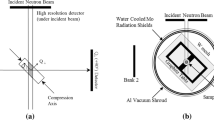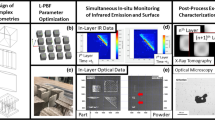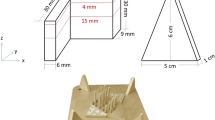Abstract
Metal components fabricated through additive manufacturing processes generally require post-processing in the form of thermal treatments in order to relieve residual stresses or facilitate development of a desired microstructure. In this work, the thermal strain response of multiple variations of 420 stainless steel made using a laser-powder bed fusion were probed during a low temperature (315 °C) heat treatment. Surface strains in both the build plane and build direction were measured in situ during the thermal cycle using a three-dimensional digital image correlation method. The effect of specimen build parameters on the thermal expansion coefficients and relief of residual strains are presented. Results show that specimens with lower layer build heights produced both slightly higher thermal expansion coefficients and higher degrees of strain relief after the thermal cycle. The addition of niobium and molybdenum content was also found to reduce the coefficient of thermal expansion and lower the strain relief found after the low temperature cycle.








Similar content being viewed by others
References
Schade C, Schaberl J, Lawley A (2007) Stainless Steel AISI Grades for PM Applications. Advances In Powder Metallurgy And Particulate Materials 2:07
Wang K, Chang B, Chen J, Fu H, Lin Y, Lei Y (2017) Effect of molybdenum on the microstructures and properties of stainless steel coatings by laser cladding. Appl Sci 7(10):1065
Angrish A (2014) A Critical Analysis of Additive Manufacturing Technologies for Aerospace Applications. In: Aerospace Conference, IEEE 2014, pp. 1–6
Frazier WE (2014) Metal Additive Manufacturing: A Review. J Mater Eng Perform 23(6):1917–1928
Gao W et al (2015) The status, challenges, and future of additive manufacturing in engineering. Comput Aided Des 69:65–89
Vastola G, Zhang G, Pei Q, Zhang Y-W (2016) Controlling of residual stress in additive manufacturing of Ti6Al4V by finite element modeling. Additive Manufacturing 12:231–239
Panda BK, Sahoo S (2018) Numerical simulation of residual stress in laser based additive manufacturing process. In: IOP Conference Series: Materials Science and Engineering, vol. 338, no. 1, p. 012030: IOP Publishing
Mukherjee T, Zhang W, DebRoy T (2017) An improved prediction of residual stresses and distortion in additive manufacturing. Comput Mater Sci 126:360–372
Liu W, Ma J, Kong F, Liu S, Kovacevic R (2015) Numerical modeling and experimental verification of residual stress in autogenous laser welding of high-strength steel. Lasers in Manufacturing and Materials Processing 2(1):24–42
Brnic J, Turkalj G, Canadija M, Lanc D, Krscanski S (2011) Martensitic stainless steel AISI 420—mechanical properties, creep and fracture toughness. Mechanics of Time-Dependent Materials 15(4):341–352
A. S. Corporation (2015) 420 stainless steel data sheet. www.aksteel.com
I. Lindquist Steels. Technical Bulletin: AISI 420 stainless steel. www.lindquiststeels.com, vol. TBA42097
Abbasi-Khazaei B, Mollaahmadi A (2017) Rapid Tempering of Martensitic Stainless Steel AISI420: Microstructure, Mechanical and Corrosion Properties. J Mater Eng Perform 26(4):1626–1633
da Silva GF, Tavares SSM, Pardal JM, Silva MR, de Abreu HFG (2011) Influence of heat treatments on toughness and sensitization of a Ti-alloyed supermartensitic stainless steel. J Mater Sci 46(24):7737–7744
Barlow LD, Du Toit M (2011) Effect of Austenitizing Heat Treatment on the Microstructure and Hardness of Martensitic Stainless Steel AISI 420. J Mater Eng Perform 21(7):1327–1336
Groen M, Zijlstra G, San-Martin D, Post J, De Hosson JTM (2018) Product shape change by internal stresses. Mater Des 157:492–500
Zijlstra G, Groen M, Post J, Ocelík V, De Hosson JTM (2016) On the role of the residual stress state in product manufacturing. Mater Des 105:375–380
Do T, Kwon P, Shin CS (2017) Process development toward full-density stainless steel parts with binder jetting printing. Int J Mach Tools Manuf 121:50–60
Ghasri-Khouzani M et al (2017) Experimental measurement of residual stress and distortion in additively manufactured stainless steel components with various dimensions. Mater Sci Eng A 707:689–700
Nelson DV (1982) Effects of residual stress on fatigue crack propagation. In: Residual stress effects in fatigue. ASTM International, West Conshohocken
Prime MB (2018) The Two-Way Relationship Between Residual Stress and Fatigue/Fracture, pp. 19–23
Bing P, Hui-min X, Tao H, Asundi A (2009) Measurement of coefficient of thermal expansion of films using digital image correlation method. Polym Test 28(1):75–83
De Strycker M, Schueremans L, Van Paepegem W, Debruyne D (2010) Measuring the thermal expansion coefficient of tubular steel specimens with digital image correlation techniques. Opt Lasers Eng 48(10):978–986
Berke RB, Sebastian CM, Chona R, Patterson EA, Lambros J (2016) High Temperature Vibratory Response of Hastelloy-X: Stereo-DIC Measurements and Image Decomposition Analysis. Exp Mech 56(2):231–243
Nath SD, Irrinki H, Gupta G, Kearns M, Gulsoy O, Atre S (2019) Microstructure-property relationships of 420 stainless steel fabricated by laser-powder bed fusion. Powder Technol 343:738–746
Davis JR, A. S. M. I. H. Committee (1994) Stainless steels (ASM specialty handbook). ASM International, Materials Park
Acknowledgements
The authors like to thank the Walmart Foundation for funding aspects of this work, and Sandvik Osprey for providing the powders used in this research work.
Author information
Authors and Affiliations
Corresponding author
Additional information
Publisher’s Note
Springer Nature remains neutral with regard to jurisdictional claims in published maps and institutional affiliations.
Rights and permissions
About this article
Cite this article
Momenzadeh, N., Nath, S., Berfield, T. et al. In Situ Measurement of Thermal Strain Development in 420 Stainless Steel Additive Manufactured Metals. Exp Mech 59, 819–827 (2019). https://doi.org/10.1007/s11340-019-00513-3
Received:
Accepted:
Published:
Issue Date:
DOI: https://doi.org/10.1007/s11340-019-00513-3




